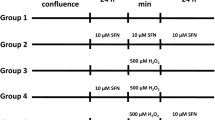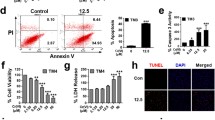Abstract
Carbon disulfide (CS2), a common organic solvent, induces a variety of adverse effects in the male reproductive system. In this study, we investigated the cytotoxicity, ultrastructural changes, and potential apoptotic induction mechanisms of CS2 in mixed cultures of Sertoli and germ cells. Sertoli and germ cells were cocultured and treated with CS2 for 24 h. Growth rates were noted, and apoptotic cells were identified by Hoechst 33258 staining. Ultrastructure changes were observed via transmission electron microscopy (TEM). Mitochondrial membrane potential and expressions of apoptosis-related factors (cytochrome c, Bax, Bcl-2, caspase-3 and caspase-9) were examined by JC-1 staining, western blot, and real-time PCR. The results showed that CS2 treatment was associated with reduced growth rates of Sertoli-germ cells. Ultrastructure changes in Sertoli-germ cells treated with CS2 were typical of apoptosis. In addition, CS2 treatment depolarized mitochondrial membrane potential, upregulated Bax levels and downregulated Bcl-2 levels, released cytochrome c from the mitochondrial intermembrane space to the cytosol, and triggered mitochondria-mediated apoptosis. Subsequently, caspase-9 and caspase-3 were activated, resulting in Sertoli-germ cells apoptosis. The above data suggest that CS2 has adverse effect on the viability of Sertoli-germ cells and induces apoptosis through mitochondrial pathway.
Similar content being viewed by others
References
Sills, R. C., Valentine, W. M., Moser, V., Graham, D. G. & Morgan, D. L. Characterization of carbon dis ulfide neurotoxicity in C57BL6 mice: behavioral, morpholog-ic, and molecular effects. Toxicol Pathol 28:142 (2000).
Chuang, W. L. et al. Carbon disulfide encephalopa-thy: cerebral microangiopathy. Neurotoxicology 28: 387 (2007).
Tan, X. et al. Carbon disulfide cytotoxicity on cultured cardiac myocyte cell of rats. Ecotoxicol Environ Saf 55: 168 (2003).
Tan, X. et al. Cross-sectional study of cardiovascular effects of carbon disulfide among Chinese workers of a viscose factory. Int J Hyg Environ Health 207:217 (2004).
Zenick, H., Blackburn, K., Hope, E. & Baldwin, D. An evaluation of the copulatory, endocrinologic, and sper-matotoxic effects of carbon disulfide in the rat. Toxicol Appl Pharmacol 73:275 (1984).
Tepe, S. J. & Zenick, H. The effects of carbon disulfide on the reproductive system of the male rat. Toxicology 32:47 (1984).
Vanhoorne, M., Comhaire, F. & De Bacquer, D. Epide-miological study of the effects of carbon disulfide on male sexuality and reproduction. Arch Environ Health 49:273 (1994).
Patel, K. G., Yadav, P. C., Pandya, C. B. & Saiyed, H. N. Male exposure mediated adverse reproductive out-comes in carbon disulphide exposed rayon workers. J Environ Biol 25:413 (2004).
Ma, J. Y. et al. The effects of carbon disulfide on male sexual function and semen quality. Toxicol Ind Health 26:375 (2010).
Huang, X. et al. Nitric oxide mediated effects on re-productive toxicity caused by carbon disulfide in male rats. Environ Toxicol Pharmacol 34:679 (2012).
Mihalache, C. & Mihalache, G. Histologic aspects of the testis in experimental carbon disulfide poisoning. Rev Med Chir Soc Med Nat Iasi 93:339 (1989).
Koji, T. & Hishikawa, Y. Germ cell apoptosis and its molecular trigger in mouse testes. Arch Histol Cytol 66:1 (2003).
Shukla, K. K., Mahdi, A. A. & Rajender, S. Apopto-sis, spermatogenesis and male infertility. Front Bios-ci (Elite Ed) 4:746 (2012).
Guo, Y. et al. Carbon disulfide induces rat testicular injury via mitochondrial apoptotic pathway. Chemo-sphere 108:367 (2014).
Gao, Y., Mruk, D. D. & Cheng, C. Y. Sertoli cells are the target of environmental toxicants in the testis-a mechanistic and therapeutic insight. Expert Opin Ther Targets 1 (2015).
Griswold, M. D. The central role of Sertoli cells in spermatogenesis. Semin Cell Dev Biol 9:411 (1998).
Lee, J., Richburg, J. H., Younkin, S. C. & Boekelheide, K. The Fas system is a key regulator of germ cell apop-tosis in the testis. Endocrinology 138:2081 (1997).
Aslam, I. & Fishel, S. Short-term in-vitro culture and cryopreservation of spermatogenic cells used for hu-man in-vitro conception. Hum Reprod 13:634 (1998).
Hue, D. et al. Meiotic differentiation of germinal cells in three-week cultures of whole cell population from rat seminiferous tubules. Biol Reprod 59:379 (1998).
Pepllonska, B., Sobala, W. & Szeszenia-Dabrowska, N. Mortality pattern in the cohort of workers exposed to carbon disulfide. Int J Occup Med Environ Health 14: 267 (2001).
Vanhoorne, M., Comhaire, F. & De Bacquer, D. Epide-miological study of the effects of carbon disulfide on male sexuality and reproduction. Arch Environ Health 49:273 (1994).
Patel, K. G., Yadav, P. C., Pandya, C. B. & Saiyed, H. N. Male exposure mediated adverse reproductive out-comes in carbon disulphide exposed rayon workers. J Environ Biol 25:413 (2004).
Ma, J. Y. et al. The effects of carbon disulfide on male sexual function and semen quality. Toxicol Ind Health 26:375 (2010).
Tepe, S. J. & Zenick, H. The effects of carbon disulfide on the reproductive system of the male rat. Toxicology 32:47 (1984).
Kumar, S. et al. Detection of germ cell genotoxic po-tential of carbon disulphide using sperm head shape abnormality test. Hum Exp Toxicol 18:731 (1999).
Huang, X. et al. Nitric oxide mediated effects on re-productive toxicity caused by carbon disulfide in male rats. Environ Toxicol Pharmacol 34:679 (2012).
Vaux, D. L. & Korsmeyer, S. J. Cell death in develop-ment. Cell 96:245 (1999).
Hikim, A. P. et al. Spontaneous germ cell apoptosis in humans: evidence for ethnic differences in the suscep-tibility of germ cells to programmed cell death. J Clin Endocrinol Metab 83:152 (1998).
Norbury, C. J. & Hickson, I. D. Cellular responses to DNA damage. Annu Rev Pharmacol Toxicol 41:367 (2001).
Guo, Y. et al. Carbon disulfide induces rat testicular injury via mitochondrial apoptotic pathway. Chemo-sphere 108:367 (2014).
Zhang, B. et al. DNA damage and apoptosis of endo-metrial cells cause loss of the early embryo in mice exposed to carbon disulfide. Toxicol Appl Pharmacol 273:381 (2013).
Brenner, D. & Mak, T. W. Mitochondrial cell death effectors. Curr Opin Cell Biol 21:871 (2009).
Danial, N. N. & Korsmeyer, S. J. Cell death: critical control points. Cell 116:205 (2004).
Kluck, R. M., Bossy-Wetzel, E., Green, D. R. and New-meyer, D. D. The release of cytochrome c from mito-chondria: a primary site for Bcl-2 regulation of apopto-sis. Science 275:1132 (1997).
Wei, M. C. et al. Proapoptotic BAX and BAK: a req-uisite gateway to mitochondrial dysfunction and death. Science 292:727 (2001).
Suen, D. F., Norris, K. L. & Youle, R. J. Mitochondrial dynamics and apoptosis. Genes Dev 22:1577 (2008).
Oltvai, Z. N., Milliman, C. L. & Korsmeyer, S. J. Bcl-2 heterodimerizes in vivo with a conserved homolog, Bax, that accelerates programmed cell death. Cell 74: 609 (1993).
Thornberry, N. A. & Lazebnik, Y. Caspases: enemies within. Science 281:1312 (1998).
Pradelli, L. A., Beneteau, M. & Ricci, J. E. Mitochon-drial control of caspase-dependent and-independent cell death. Cell Mol Life Sci 67:1589 (2010).
Porter, A. G. & Janicke, R. U. Emerging roles of caspase-3 in apoptosis. Cell Death Differ 6:99 (1999).
Adhikari, N., Sinha, N. & Saxena, D. K. Effect of lead on Sertoli-germ cell coculture of rat. Toxicol Lett 116: 45 (2000).
Mosmann, T. Rapid colorimetric assay for cellular growth and survival: application to proliferation and cytotoxicity assays. J Immunol Methods 65:55 (1983).
Author information
Authors and Affiliations
Corresponding authors
Additional information
These authors contributed equally to this work.
Rights and permissions
About this article
Cite this article
Wang, W., Zhang, Z., Guo, Y. et al. Carbon disulfide induces mitochondria-mediated apoptosis in Sertoli-germ cells coculture. Mol. Cell. Toxicol. 11, 175–185 (2015). https://doi.org/10.1007/s13273-015-0016-4
Received:
Accepted:
Published:
Issue Date:
DOI: https://doi.org/10.1007/s13273-015-0016-4




